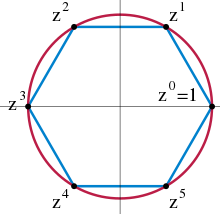Group (mathematics)
In mathematics, a group is a set of elements together with a conjunction that assigns a third element of the same set to every two elements of the set, satisfying three conditions, the group axioms: the associative law, the existence of a neutral element, and the existence of inverse elements.
One of the best known groups is the set of integers with addition as the link. The mathematical branch devoted to the study of group structure is called group theory. It is a subfield of algebra. The applications of groups, even outside mathematics, make them a central concept in contemporary mathematics.
Groups share a fundamental kinship with the idea of symmetry. For example, the symmetry group of a geometric object embodies its symmetric properties. It consists of the set of those mappings (e.g. rotations) which leave the object unchanged, and the succession of such mappings as a linkage. Lie groups are the symmetry groups of the Standard Model of particle physics, point groups are used to understand symmetry at the molecular level in chemistry, and Poincaré groups can express the symmetries underlying special relativity.
The concept of group arose from Évariste Galois' investigations of polynomial equations in the 1830s. Following contributions from other mathematical fields such as number theory and geometry, the notion of group was generalized. By 1870 it was firmly established and is now treated in the distinct field of group theory. To study groups, mathematicians have developed special notions to break groups down into smaller, more easily understood components, such as subgroups, factor groups, and simple groups. In addition to their abstract properties, group theorists also study ways in which groups can be expressed concretely (representation theory), both for theoretical investigations and for concrete calculations. A particularly rich theory has been developed for finite groups, culminating in the classification of finite simple groups in 1983. These play a comparable role for groups as prime numbers do for natural numbers.

The turns of a Rubik's Cube form a group.
Introductory example
One of the best known groups is formed by the set of integers , 

The set of integers together with addition satisfies some basic properties:
- For two integers
and the sum
is
again an integer. On the other hand, if you were to divide two integers together, the result would mostly be a rational number and no longer an integer. Since this cannot happen with addition, the integers are said to be completed under addition.
- For all integers
,
and the associative law applies

In words, this means that it doesn't matter whether you first 



- For any integer following applies

Therefore, the addition with zero does not change the initial number. Therefore, zero is called the neutral element of addition.
- For every integer
there exists an integer
such that
. That is, for every integer
there exists an integer
such that their sum is zero. In this case, the number
is called the inverse element of
and is
notated as
These four properties of the set of integers together with their addition are generalized to other sets with a suitable operation in the definition of the group.
Examples
In the following some examples of groups are given. Thus groups of numbers, a group with exactly one element and examples of cyclic groups are given. Further examples of groups can be found in the list of small (finite) groups.
sets of numbers
- The set of integers together with addition forms an (abelian) group. Together with multiplication, however, the set of integers is not a group (the inverse element of 2 would be 1/2).
- The set of rational numbers
respectively the set of real numbers
with addition is a group. Together with multiplication, the sets
and
also groups.
The trivial group
→ Main article: Trivial group
The set which has only one element 

Cyclic groups
→ Main article: Cyclic group
A cyclic group is a group whose elements can be represented as powers of one of its elements. Using multiplicative notation, the elements of a cyclic group are

where 


can be displayed.
For example, the additive group of integers considered in the first section is a cyclic group with primitive root 

satisfy. The 



Cyclic groups have the property of being uniquely determined by the number of their elements. That is, two cyclic groups each with 

Symmetrical groups
→ Main article: Symmetric group
The symmetric group 





The 6th complex unit roots can be taken as a cyclic group.
Search within the encyclopedia


